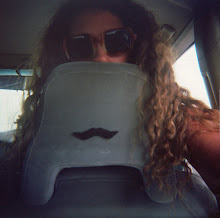I am awake with ideas.
I laid in bed for a long time, staring up at a full moon between the crack in the curtains above my head. I was trying to keep my eyes open, trying not to blink, like the moon and I were having a staring contest. I wanted to watch it as closely as I could. I thought that if I stared long enough, hard enough, I might be able to see it move, actually perceive its movement. I lost, of course.
But it's not really the moon that moves, is it? It's us. Sometimes we forget that the world turns. Sometimes I hope that, if I just focus, I will be able to feel it turning.
One night a few weeks ago, while riding in the car with friends, we all noticed the moon rising on the horizon at exactly the same moment, and we all screamed in unrestrained amazement. Its enormity was directly centered between the tall buildings at the end of the street, its girth stretched from curb to curb. It felt like if we kept going we would be able to drive right up to it, get out, and touch its yellow bumpiness. So we decided to drive to the very end, where the street met the river, attempting to get just a little bit closer. But the closer we got, the smaller it became. That's when I learned about "the moon illusion", which is a theory that explains why the moon looks larger on the horizon than it does higher up in the sky. Its size doesn't actually change at all, but our perception of it changes. The ability to compare a low-hanging moon to objects in closer proximity makes it appear larger than when it's up in the sky, all by itself. Scale and movement only exist by comparison.
Perception is an underlying element in much of my artwork. I am obsessed with creating things that move so slowly that the movement can't be immediately perceived. My Coffee Cup Conveyor Belt Calendar moves a mere 5 9/16" per day. Movement that gradual cannot be detected by the naked eye, but it is made evident by the soft ticking of the clock motor that drives it, and by the pile of broken cups on the floor adjacent to it. The viewer is required to notice that evidence, to invest time and energy in exploring the situation, in order to understand what's happening.
My favorite word associated with time is "now." How does one measure the length of now? How can we possibly perceive now? It is both always and never now. "Now" I am typing this sentence. "Now" you are reading this email. "Now" I am 28 years old. I am infatuated with this expression and the many ways it can be interpreted. One of my most recent projects takes measuring "the length of now" very literally, in terms of both duration and physical distance. I have been soaking pieces of red wool yarn in water, writing the word 'now' in cursive with their line, and then placing these 'nows' in a freezer. Once frozen, each now can be removed from the freezer and hung on the wall, where it retains its shape and meaning for a very short period of time before it begins to melt (they sometimes even melt in your hand). The duration of each 'now' depends on its previous construction, its size, and the style of handwriting used to write it. Once it has completely melted, the 'now' returns to that which it once was... just a piece of yarn, that was cut to be however long at the time of its creation (the time which was once now, but is now then).
Jonah Lehrer, author of Proust was a Neuroscientist, said "the past is at once perpetual and ephemeral…. the past is never past." And so, too, is the present. I have a whole freezer full of 'nows' to prove it.
Yours truly,
Alicia


No comments:
Post a Comment